Abstract
OBJECTIVES: To analyse the association between symptoms from the musculoskeletal system and many psychosocial and other physical stressors in the job demand-control-support model. Also to analyse the influence of personality characteristics. METHODS: 1306 salespeople answered a self administered questionnaire on job characteristics, exposures, personality characteristics, social network, smoking and drinking habits, and symptoms of the neck, shoulders, and low back. RESULTS: In multivariate analyses, high job demands were related to neck and shoulder symptoms (ORs 1.43-1.47 in the highest exposure groups compared with the lowest), and tendency to become overworked and lack of social support from colleagues were related to back pain (OR 1.81-2.04 in the highest exposure groups compared with the lowest). Lack of variation in the job, low control over time, and high competition were related to neck symptoms, but there was an interaction so that both low control over time and high competition had to be present to increase the OR. Also, driving long distances and sedentary work were related to neck and low back pain, and time spent in the car to shoulder pain (ORs 1.64-2.80 in the three highest groups v the lowest exposure groups). CONCLUSION: Both psychosocial and physical factors were associated with musculoskeletal symptoms. Many dimensions of the demand-control-support model were associated with symptoms. Only one personality characteristic, tendency to feel overworked, significantly influenced the prevalence of musculoskeletal symptoms.
Full text
PDF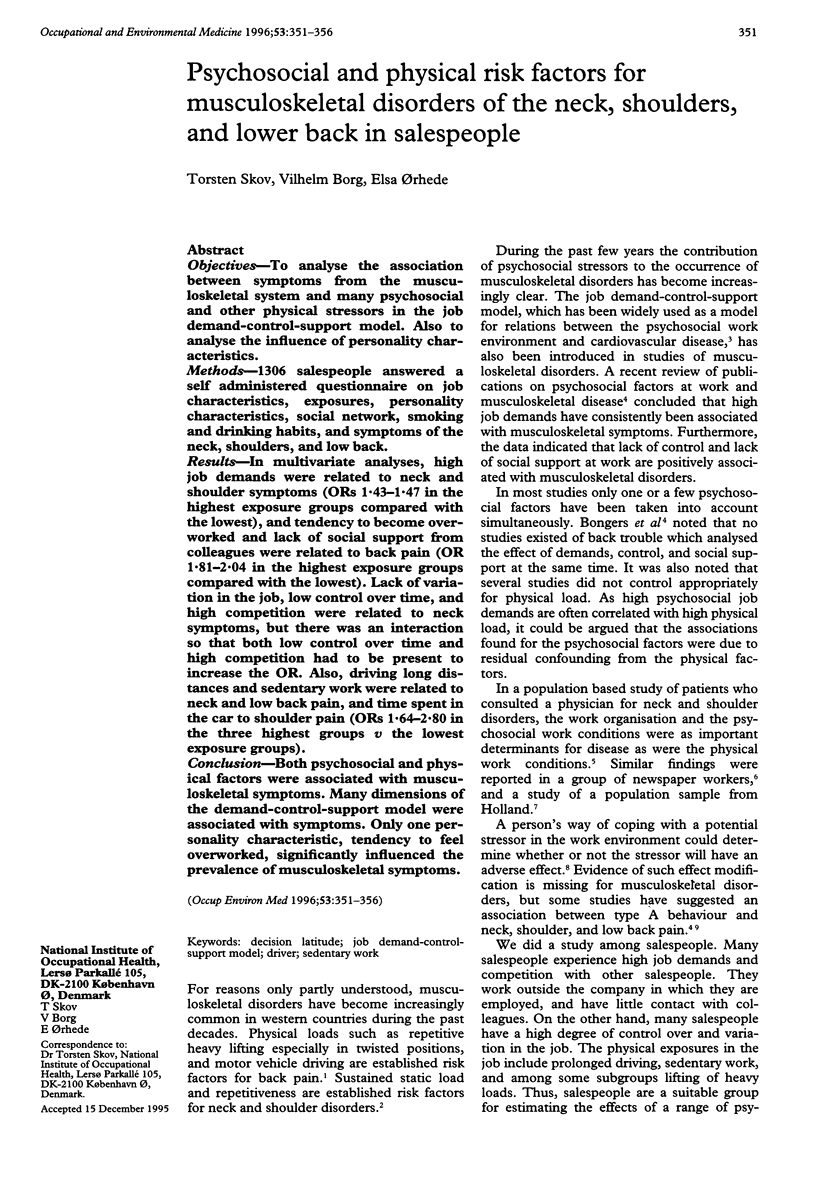
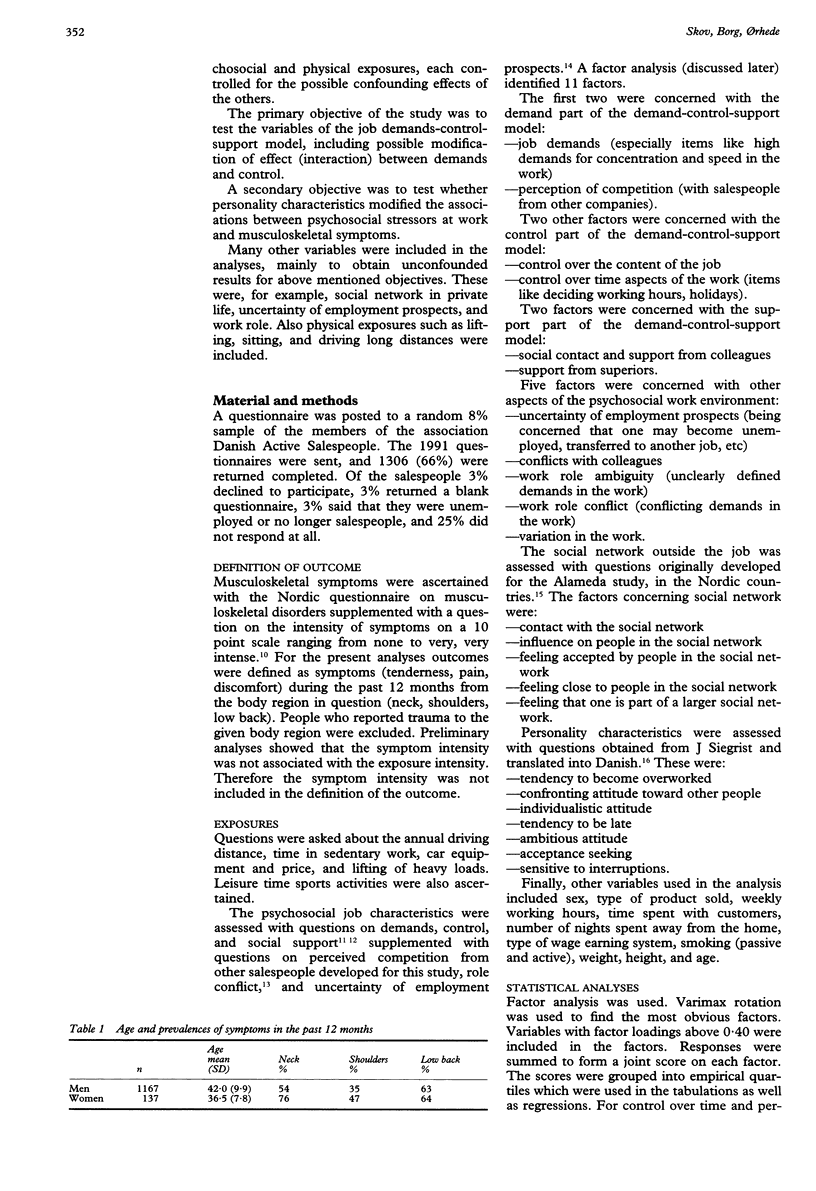
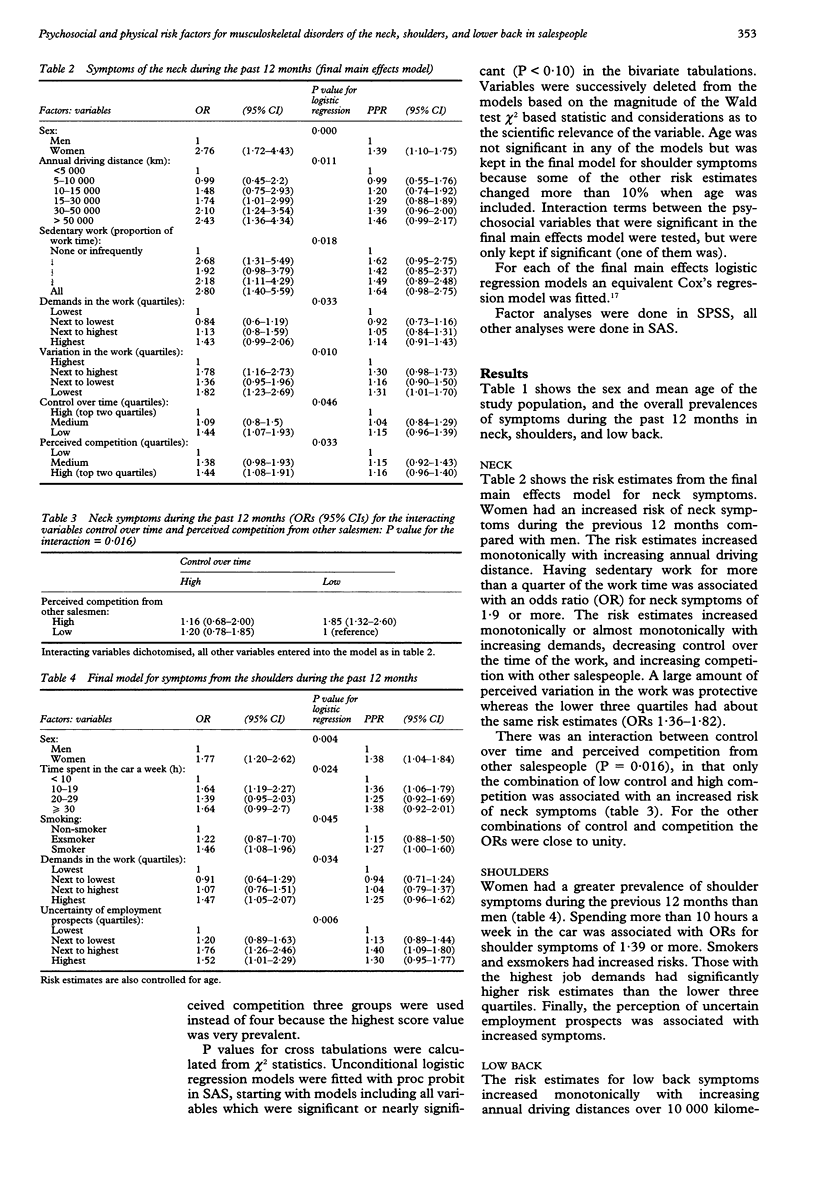
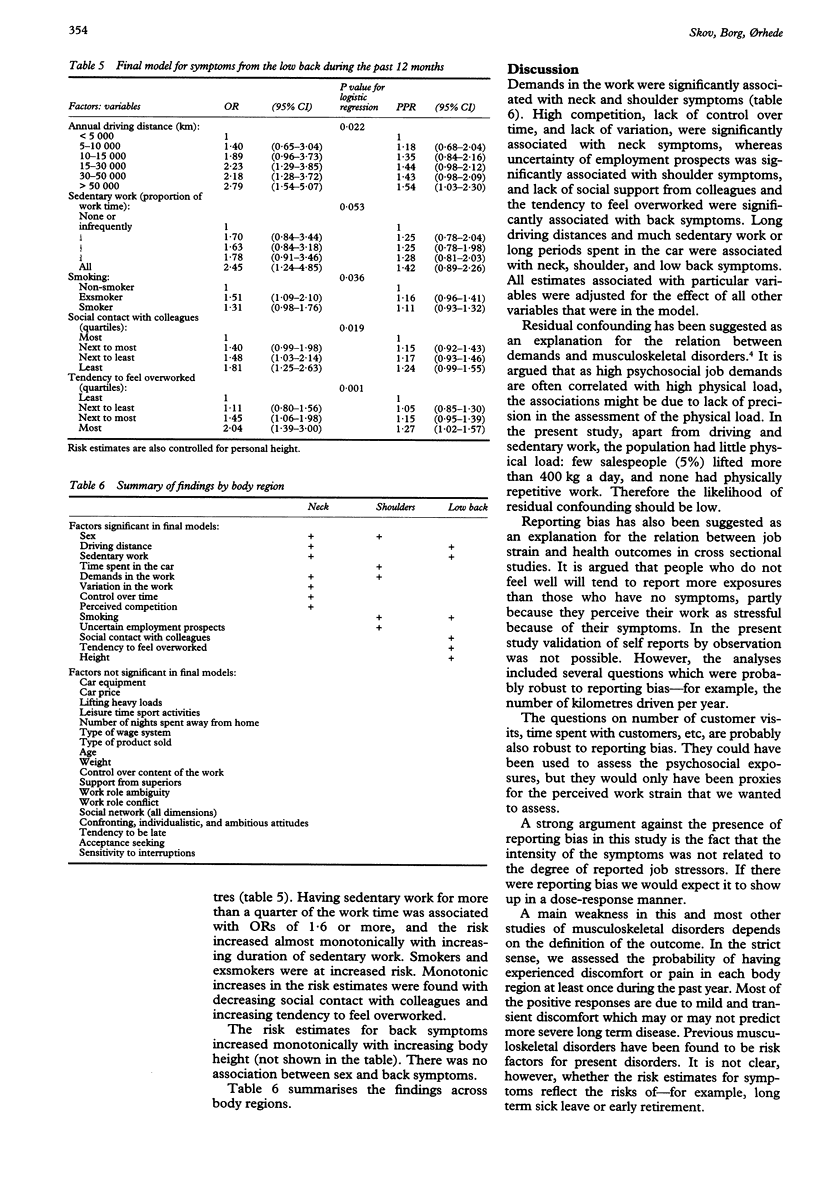
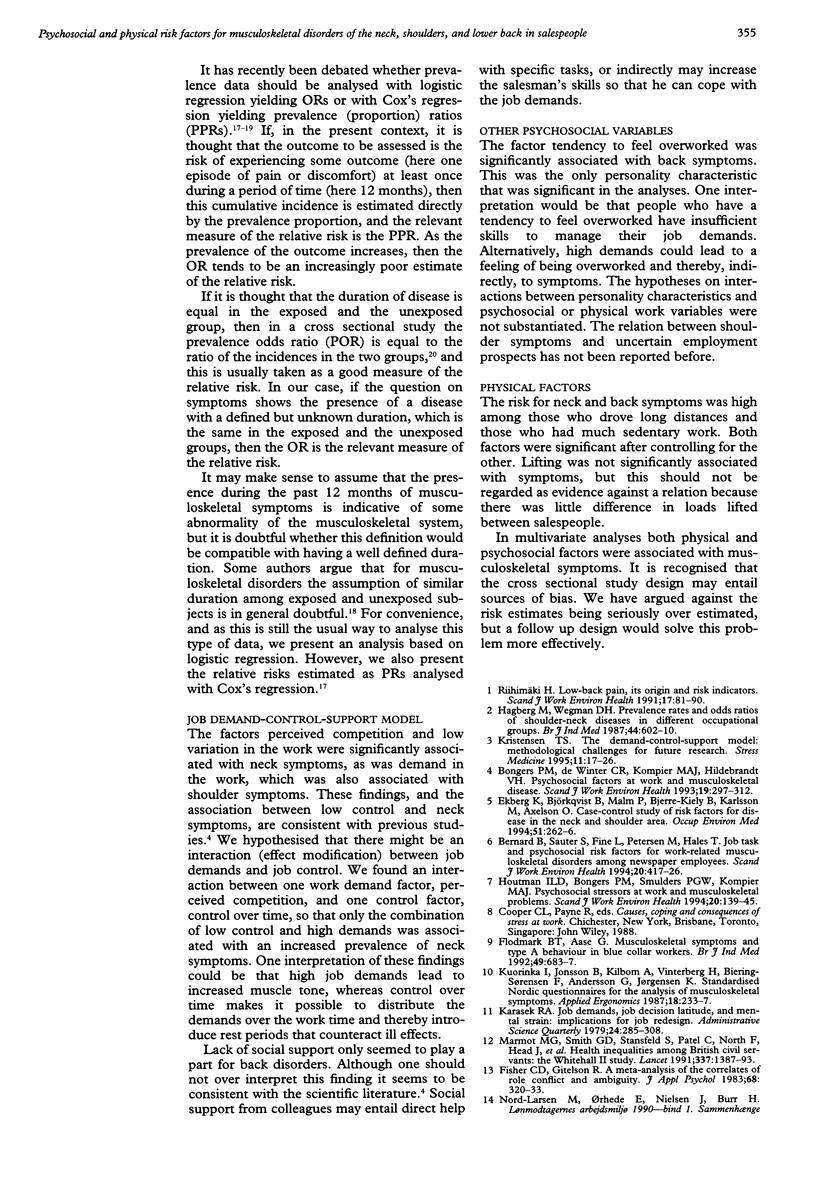
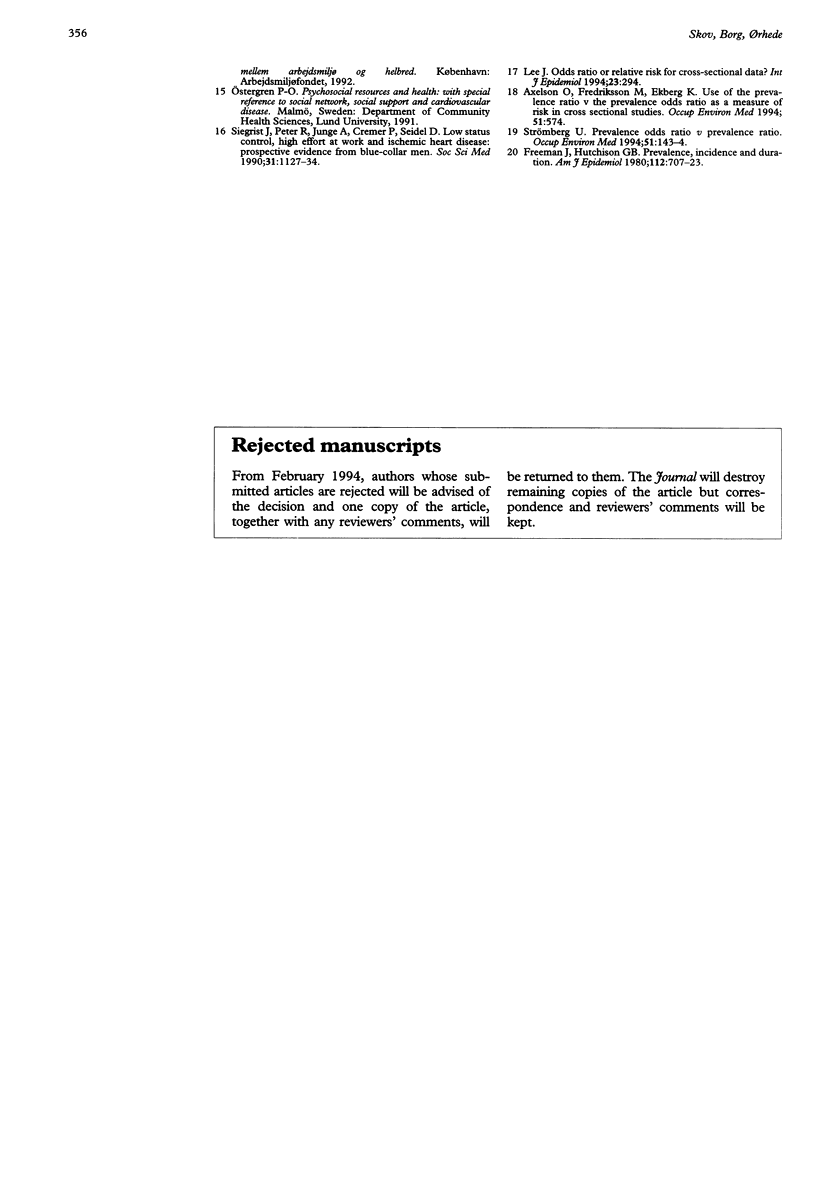
Selected References
These references are in PubMed. This may not be the complete list of references from this article.
- Axelson O., Fredriksson M., Ekberg K. Use of the prevalence ratio v the prevalence odds ratio as a measure of risk in cross sectional studies. Occup Environ Med. 1994 Aug;51(8):574–574. doi: 10.1136/oem.51.8.574. [DOI] [PMC free article] [PubMed] [Google Scholar]
- Bernard B., Sauter S., Fine L., Petersen M., Hales T. Job task and psychosocial risk factors for work-related musculoskeletal disorders among newspaper employees. Scand J Work Environ Health. 1994 Dec;20(6):417–426. doi: 10.5271/sjweh.1379. [DOI] [PubMed] [Google Scholar]
- Bongers P. M., de Winter C. R., Kompier M. A., Hildebrandt V. H. Psychosocial factors at work and musculoskeletal disease. Scand J Work Environ Health. 1993 Oct;19(5):297–312. doi: 10.5271/sjweh.1470. [DOI] [PubMed] [Google Scholar]
- Ekberg K., Björkqvist B., Malm P., Bjerre-Kiely B., Karlsson M., Axelson O. Case-control study of risk factors for disease in the neck and shoulder area. Occup Environ Med. 1994 Apr;51(4):262–266. doi: 10.1136/oem.51.4.262. [DOI] [PMC free article] [PubMed] [Google Scholar]
- Flodmark B. T., Aase G. Musculoskeletal symptoms and type A behaviour in blue collar workers. Br J Ind Med. 1992 Oct;49(10):683–687. doi: 10.1136/oem.49.10.683. [DOI] [PMC free article] [PubMed] [Google Scholar]
- Freeman J., Hutchison G. B. Prevalence, incidence and duration. Am J Epidemiol. 1980 Nov;112(5):707–723. doi: 10.1093/oxfordjournals.aje.a113043. [DOI] [PubMed] [Google Scholar]
- Hagberg M., Wegman D. H. Prevalence rates and odds ratios of shoulder-neck diseases in different occupational groups. Br J Ind Med. 1987 Sep;44(9):602–610. doi: 10.1136/oem.44.9.602. [DOI] [PMC free article] [PubMed] [Google Scholar]
- Houtman I. L., Bongers P. M., Smulders P. G., Kompier M. A. Psychosocial stressors at work and musculoskeletal problems. Scand J Work Environ Health. 1994 Apr;20(2):139–145. doi: 10.5271/sjweh.1419. [DOI] [PubMed] [Google Scholar]
- Kuorinka I., Jonsson B., Kilbom A., Vinterberg H., Biering-Sørensen F., Andersson G., Jørgensen K. Standardised Nordic questionnaires for the analysis of musculoskeletal symptoms. Appl Ergon. 1987 Sep;18(3):233–237. doi: 10.1016/0003-6870(87)90010-x. [DOI] [PubMed] [Google Scholar]
- Marmot M. G., Smith G. D., Stansfeld S., Patel C., North F., Head J., White I., Brunner E., Feeney A. Health inequalities among British civil servants: the Whitehall II study. Lancet. 1991 Jun 8;337(8754):1387–1393. doi: 10.1016/0140-6736(91)93068-k. [DOI] [PubMed] [Google Scholar]
- Riihimäki H. Low-back pain, its origin and risk indicators. Scand J Work Environ Health. 1991 Apr;17(2):81–90. [PubMed] [Google Scholar]
- Siegrist J., Peter R., Junge A., Cremer P., Seidel D. Low status control, high effort at work and ischemic heart disease: prospective evidence from blue-collar men. Soc Sci Med. 1990;31(10):1127–1134. doi: 10.1016/0277-9536(90)90234-j. [DOI] [PubMed] [Google Scholar]
- Strömberg U. Prevalence odds ratio v prevalence ratio. Occup Environ Med. 1994 Feb;51(2):143–144. doi: 10.1136/oem.51.2.143. [DOI] [PMC free article] [PubMed] [Google Scholar]


